Batten down the hatches
Storm Agnes rolled through last week, leaving us shaken but not stirred. Inevitably a few trees were brought down as most are still in full leaf. Again inevitably, one hit the power lines that serve the peninsula leaving us – literally – in the dark for a few hours. Our electricity supplier visits most years felling trees that are too close to the lines – I’ve just split and stacked over 3 m3 of larch they felled this summer – but the storms seem to have a knack of finding trees they left standing that should have got the chop.
A power outage of only a few hours is sufficient to justify getting the camping gas stove to make tea, but not long enough to rummage through the shed to find the portable generator {{1}} and extension cables.
Not collecting the generator also saves me getting half-drowned walking swimming to the shed and back … it’s raining really hard {{2}}.
Have you noticed how hard it seems to rain these days? My weather station recorded a recent rain squall at a rate over 130 mm/hr. Fortunately, only for a short period or I’d be revisiting the SEPA flood maps to check if our steeply sloping land is at actually at risk after all.
All of which is a preamble for this week’s post on securing hives for the winter ahead.
If they’re not tied down yet, they should be. And, increasingly, they should be secured all year round.
There’s a lot of it about
Weather, that is.
Over the last few decades I’ve lived in southern England, the Midlands and Scotland. There’s weather everywhere, but it certainly seems as though there’s a lot more of it these days. Droughts are dryer, rainfall is wetter (or at least harder), summers are hotter and winds are stronger. Whatever the weather, it’s getting more extreme.
This is not a UK phenomenon, or a distorted view because I’ve lived in Scotland for the last decade, it’s global. Rarely a week goes by without the news covering a ‘once in a century’ weather event somewhere; flash floods in New York City, the ‘gobsmackingly bananas‘ global temperature this September, or bomb cyclones affecting 60% of the US population.
Show us the money
Although these extremes can be simply documented in terms of higher temperature maxima or amounts of rain, it is the consequences of the weather extremes that really emphasise the changes over the recent past. This is perhaps best illustrated graphically in terms of extreme weather events and associated financial losses (or costs).
The US National Centres for Environmental Information have an excellent dataset and – more importantly – an interactive webpage allowing you to visualise the frequency and cost of billion-dollar weather and climate events over the last 40 years {{3}}.
It makes sobering viewing {{4}} and, with a general reluctance to properly tackle climate change, we can expect more of the same.
Climate change will affect our bees and beekeeping both in terms of forage availability, pathogen exposure and overwintering success as well as things as mundane as getting drooked visiting the apiary.
Natural disasters
I’ve previously expressed some scepticism of the accuracy of winter loss surveys conducted by beekeeping associations and others. Nevertheless, the losses are recorded and there is usually a category termed ‘natural disasters’ … a sort of catchall that covers everything from biblical floods, falling trees, earthquakes, strigilating cattle and meteor strikes {{5}}.
Where they recorded it, the COLOSS survey (covering ~30 largely northern hemisphere countries) reports losses due to natural disasters of no more than 1-2%. COLOSS defines natural disasters as:
… the causes can be very different in participating countries, including fire, storm, flooding, vandalism, bears, martens, woodpeckers, falling trees, suffocation from snow and many more.
at least some of which are avoidable. Equivalent US surveys report a similar ‘insignificant’ figure of ~2.5% (Kulhanek et al., 2017).
Insignificant that is, unless you happen to be the beekeeper.
Or the bees.
Other than meteor strikes (which I’ll probably never cover), woodpeckers and vandalism (which I have previously discussed), many of these natural disasters can be avoided by choosing your apiary location reasonably carefully.
Don’t just consider the possibility of the hives floating away in a flood … think also about accessing the apiary if the ground is waterlogged. If there are large trees overhanging the site, or immediately adjacent, then check they’re not at risk of falling (or get a friendly tree surgeon to do so).
And then consider long-term improvements to reduce the possibility of storm damage … and improving the micro-environment for your hard-working returning foragers.
Gimme shelter
‘Ooh, a storm is threatening’ {{6}} … so reduce the impact by planting a shelter belt of trees or bushes around the apiary to reduce the wind speed.
Alternatively – or as well – consider adding protective netting to reduce the wind speed … a quick and dirty, but surprisingly effective, solution.
One of my Fife apiaries is located on a raised earth mound and, when first set up, was very exposed to the westerlies. The apiary is fenced and one of the first things I did was add mesh netting all around the western perimeter. This stuff is designed to protect growing crops. It’s exactly the same, albeit in more environmental colours, as the netting placed around scaffolding to stop people walking underneath {{7}}.
This mesh is a very effective as a windbreak, reducing the windspeed by 25-50%. It makes life a little easier for returning foragers on their approach to the hive entrance as well as reducing the impact of potentially damaging gusts.
But, it’s not hugely visually appealing …
Hedging
A longer term and more aesthetically pleasing solution is to plant a hedge.
The best shelter is provided by an evergreen hedge, but they are usually far less good for wildlife. It might be better to plant a thicker deciduous hedge and rely upon the dense growth – even sans leaves – to reduce the wind speed.
Mixed native hedging is available from several suppliers, most economically bought ‘bare rooted’ for winter planting. If you do this be aware that some suppliers source their ‘native’ hedging from other countries … just because they’re called “Scotplants” don’t assume the plants are from Scotland {{8}}.
I planted mixed native hedging – largely alder, wild rose, hawthorn and a few other things – with lots of willow several years ago. The willow are now 3-4 metres high and really need coppicing. I’ll do this on a rotation so that the majority of the hedge is maintained. The coppiced trees will rapidly regrow, with multiple stems that will further improve the windbreak and the amount of spring pollen and nectar for the bees.
Batten down the hatches
This of course is a nautical term referring to the use of wooden battens to secure tarpaulins over the hatch covers of sailing ships. However, it more generally means ‘to prepare for trouble or a difficult situation’.
Even with a windbreak, freak gusts – either in strength or direction – can still batter the hives. It is therefore important, particularly during the winter when storms are more severe and deciduous windbreaks less effective, to secure the hives properly.
If you don’t then roofs can get blown off or the entire hive can be blown over.
I’ve had both happen, though have yet to lose a colony.
A few seasons ago the roofs and crownboards of two poly nucs were blown off in a summer storm. The bees were exposed for over a week and – after yet more wind and rain – were looking decidedly sorry for themselves when I next visited the apiary. However, the seams of bees in these densely populated nucs must have created a remarkably water-resistant barrier as the queen was still laying when I checked them.
The same storm knocked over a complete hive topped with several full supers. This was tightly strapped together and remained intact … but horizontal. Despite laying ‘face down’ the bees could still squeeze out of the hive entrance and the colony survived, as did the honey.
The hive was top heavy and the hive stand was rather narrow. However, without the strap the boxes would have separated and the colony would have probably been robbed mercilessly.
There have been a few other near misses, but these were the only two I’d photographed.
Bricks or straps?
I think that last example neatly demonstrates the advantage of strapping a hive together rather than just relying on bricks to hold the roof down.
Bricks or any heavy alternative like clay roofing tiles, large stones or – in an emergency – boxes of fondant {{9}}, will certainly help keep the roof on. However, if displaced by a strong gust of wind then the hive is at the mercy of subsequent gusts, and the rain that probably accompanies them.
I know some beekeepers use the orientation of a brick to indicate the status of the hive; queenless, swarm control, queen mating etc {{10}}. However, I have enough problems deciphering my hive notes which appear to be written in Linear B, without having to take the positional information of a brick into account as well.
So I use hive straps almost all of the time and have acquired a range of different types over the years. Despite being different lengths and colours, all fall into one of three types, each of which has good points and bad points.
Classic or ‘standard’ hive strap
These have no moving parts so there’s nothing to work loose, go wrong or break. Once tightened in place they remain tight and secure.
However, fitting them isn’t necessarily intuitive {{11}}.
They are tightened using a cantilever action which then allows the strap to be secured in place through the split metal handle/bracket. Rather than describe it badly I suggest you instead watch the useful video produced by Thorne’s.
Note that it’s easier to position the handle/bracket adjacent to a recess in the hive wall (as shown in the video) than flat against a hive wall or roof.
Also note that you sometimes don’t have the option …
If done up properly these are just about completely foolproof. I’ve got a bagful of them … because I usually use something else.
Ratchet straps
These are tightened with a ratchet action, a spring-loaded detent then needs to be released to relieve the tension and release the strap. This type of strap can be done up extremely tightly, in fact, so tightly you can damage the hive.
Take care, particularly with poly hives.
I’ve found these straps to be almost infallible and useful for all sorts of other purposes. When I transport supers in the car I secure them together with a ratchet strap as this quietens the usual cacophony of squeaks as the poly supers shiggle against each other.
When I’m moving hives over rough ground on the hivebarrow a ratchet strap is my first choice for ensuring the hive and the barrow remain together, whatever the terrain throws at us.
Ratchet straps, at least those of the width beekeepers use {{12}}, are often manufactured with a 5 metre webbing strap. Don’t buy them with less than this. The ratchet/connection mechanism is sufficiently strong that they will secure teetering towers of boxes should the need arise, but only if the strap is long enough.
I’ve had one or two ratchet straps fail or jam over the years, but they’re out in all weathers and barely get any attention or TLC.
Economy tie down or cam straps
These are variously called tie down straps, cam straps, tensioning belts or cargo straps, often with the term ‘quick release’ appended to the name. They consist of a woven polypropylene or nylon strap terminated by a simple spring-operated cam buckle.
I use loads of these. They are very cheap – the ones I most recently got were £8 for 6 – and more than strong enough for most normal use {{13}}. In comparison to either of the straps above they are easy to tighten or slacken off; you thread the end of the strap through the buckle and pull to tighten, or press the spring operated cam (a one handed operation, in contrast to either of the above) to undo.
Don’t bother buying anything under 2.5 metres in length unless it’s only for nucs.
These straps aren’t the strongest or the most dependable, but they’re more than adequate for most beekeeping in my view. They fail when the return spring breaks/corrodes or the cam gets stuck ‘open’. Give the spring and cam and spring a spray with WD40 every 6 months or so and they’ll give you years of service.
Strap up and tie down
Although it’s beneficial to strap the hive up to stop the roof disappearing over the apiary fence, it’s even better to secure the entire hive to the hive stand. Yes – as shown above – things can still topple over, but it’s much less likely.
I build my wooden hive stands with cross beams (perpendicular to the longitudinal supports) which I pass the strap around before tightening everything up. Alternatively, assuming there’s no landing board at the hive entrance, you can simply pass the strap over the hive – front to back – and around the longitudinal supports. The bees don’t mind … in fact some choose to land on the strap rather than the smoother face of the hive.
In a really windy location I’ve seen hive straps secured underneath the paving slab on which the hive was standing. If you use wooden pallets as hive stands then you have a good wide base to secure the hive to {{14}}.
And tidy up
This is one of those ‘Do as I say, not as I do’ moments.
Keep your unused hive straps tidy. If, as I tend to during the season, you just dump them into a bag they will inevitably get tangled. Taking the one out you want becomes an exercise in frustration and really bad language.
It’s far better to roll/fold the strap up and then secure the rolled strap to the buckle or ratchet. You can use elastic bands for this, though they may perish over time and sometimes ping off into the long grass never to be seen again.
Alternatively, and better, use a wide but relatively short reusable zip tie.
I try and tidy any unused straps during the winter so I’m ready for the season ahead. Of course, the winter is when most straps are in use, so I’ll still be faced with an unbelievable tangle sometime in the summer (again).
Notes
Omitted from the list above – as it’s not secure enough for use in the apiary – are Velcro straps. You can buy 25 metre rolls of 2 cm Velcro (or more probably a generic ‘hook and loop’ product) that can be cut to length and used to hold lids on nucs in storage. This stuff is often sold for tidying cables out of the way, but is useful for a variety of things in the shed or during transit. However, I wouldn’t recommend risking transporting a box full of bees ‘secured’ with this type of strap.
But, inevitably, I have … and all was OK.
References
Kulhanek, K., Steinhauer, N., Rennich, K., Caron, D.M., Sagili, R.R., Pettis, J.S., et al. (2017) A national survey of managed honey bee 2015–2016 annual colony losses in the USA. Journal of Apicultural Research 56: 328–340.
{{1}}: Usually used to power the oxalic acid vaporiser.
{{2}}: Almost 300 mm in the second half of September
{{3}}: If readers are aware of a UK or European equivalent please add it in the comments.
{{4}}: As do the statistics on excess deaths due to climate extremes.
{{5}}: OK, I probably invented a couple of these … and it’s worth remembering that the reality is that most losses are due to Varroa and DWV, even though some are probably miscategorized as natural disasters by survey respondents.
{{6}}: Gimme shelter by The Rolling Stones
{{7}}: Hint … check skips for metres of this stuff discarded at building sites
{{8}}: Many are from Holland
{{9}}: Been there, done that.
{{10}}: It’s probably apocryphal but I’m also told that some farmer’s wives use the brick to indicate to the beekeeper the presence or absence of the farmer ;-)
{{11}}: At least, it isn’t to me.
{{12}}: Usually ~25 mm, but you can get much wider/stronger ones to secure loads on lorries.
{{13}}: I use exactly the same design of strap (although longer and better quality) to secure my canoe to my car; the canoe is worth more than the car and I’m happy to drive at 50 mph, trusting the straps keep everything together.
{{14}}: And a bad back from bending over the hive when doing inspections!

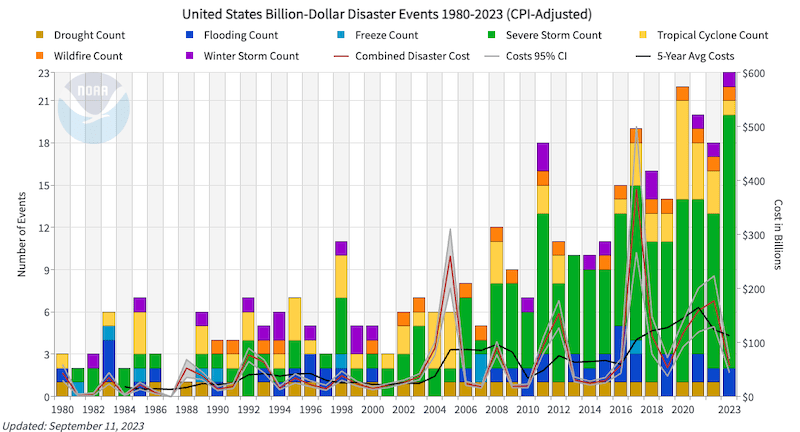
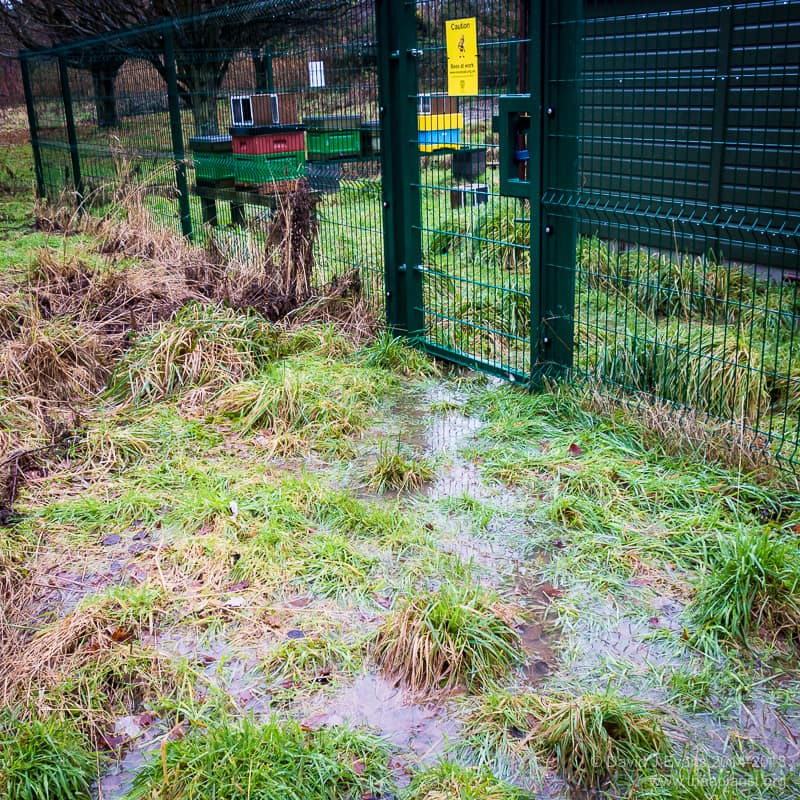
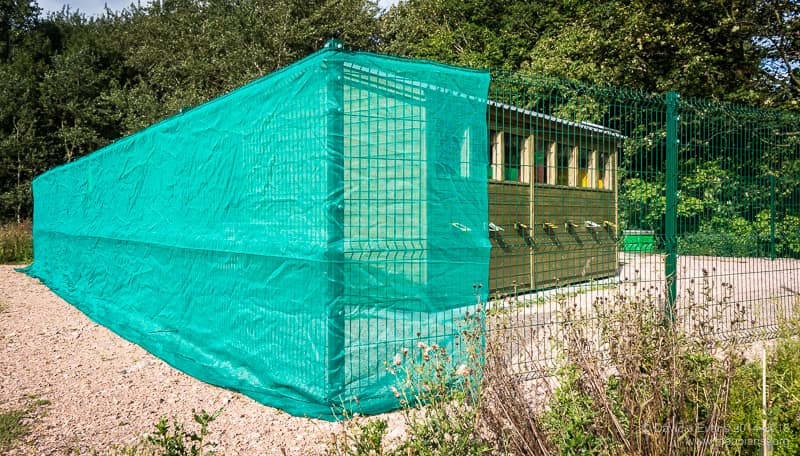
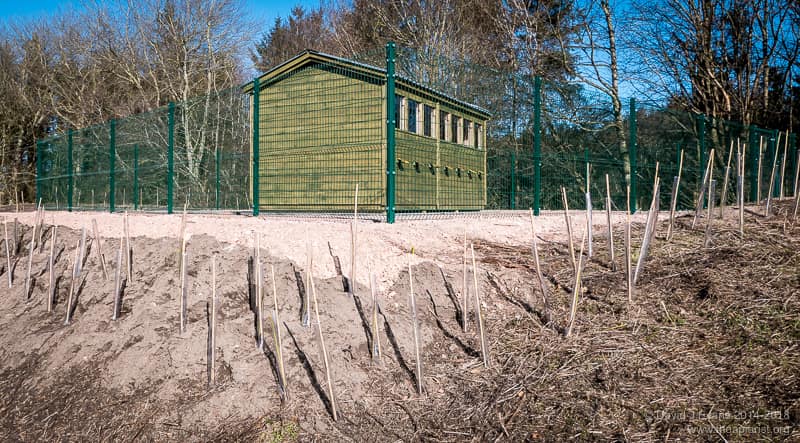

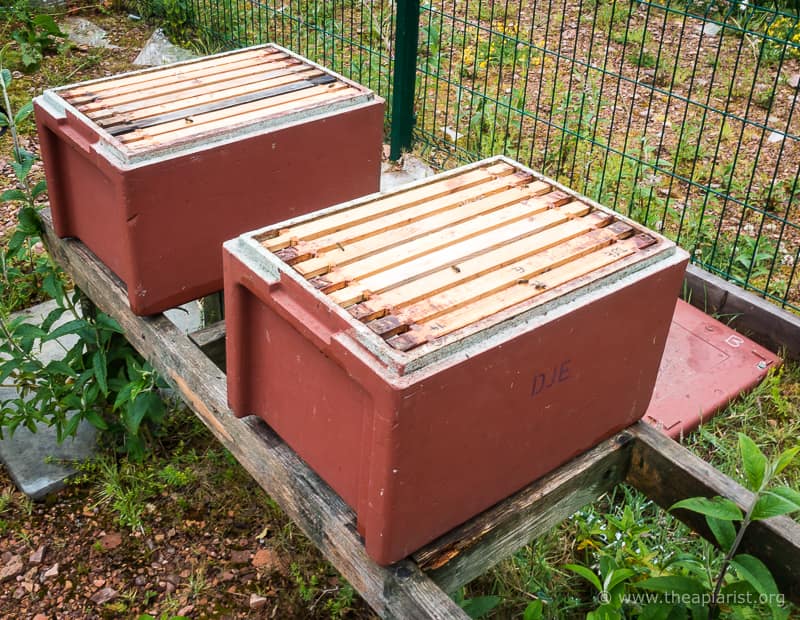
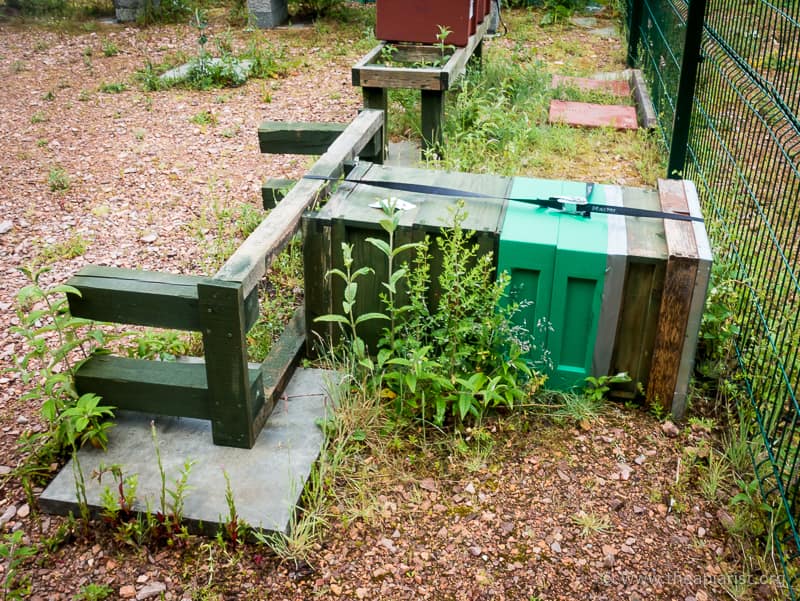
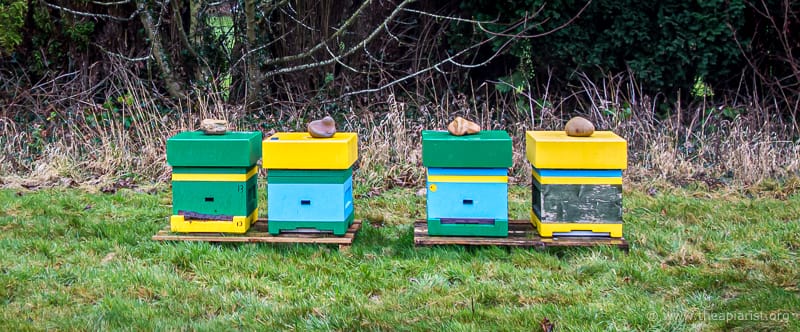
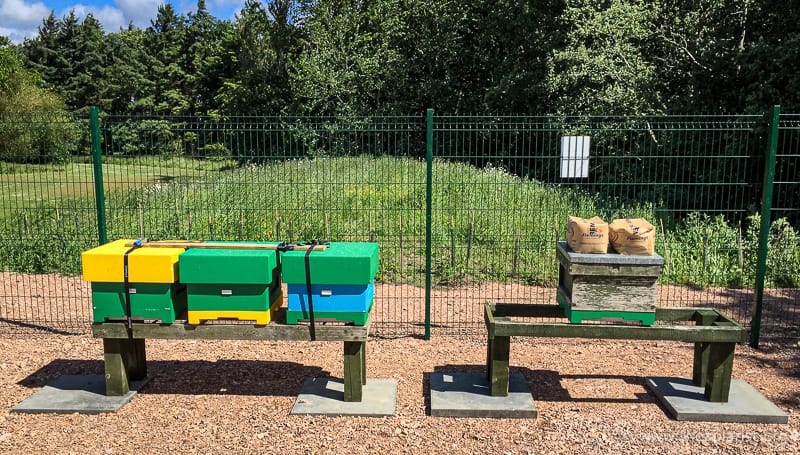
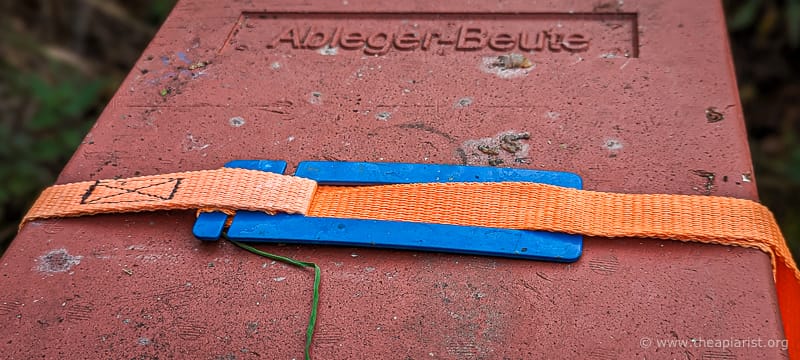
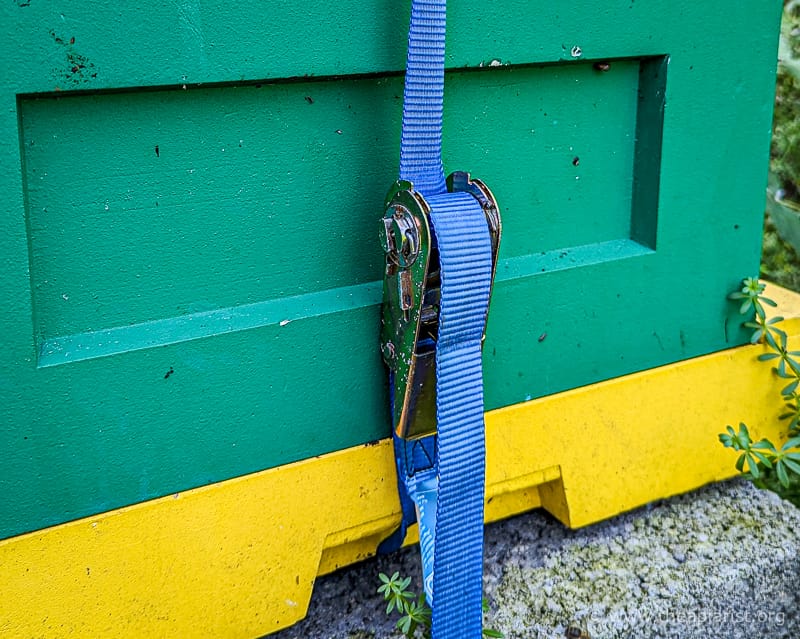
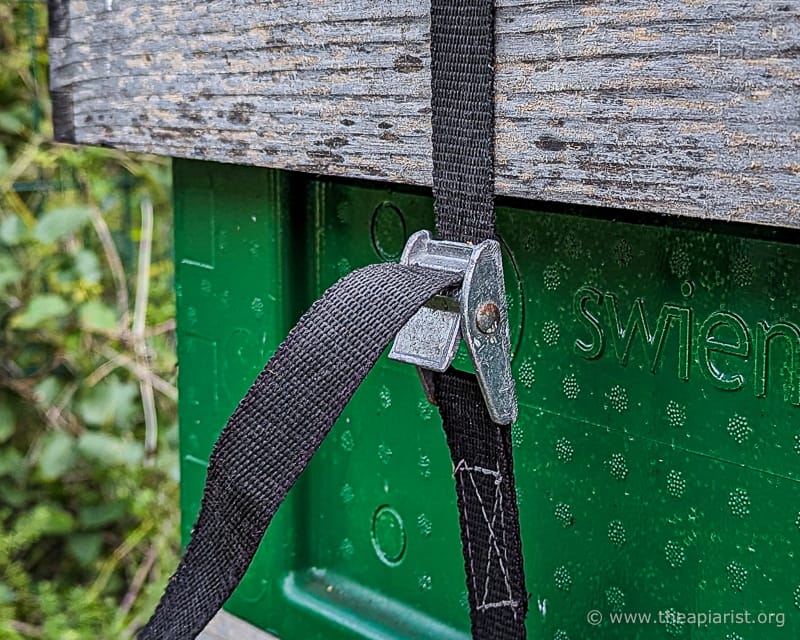
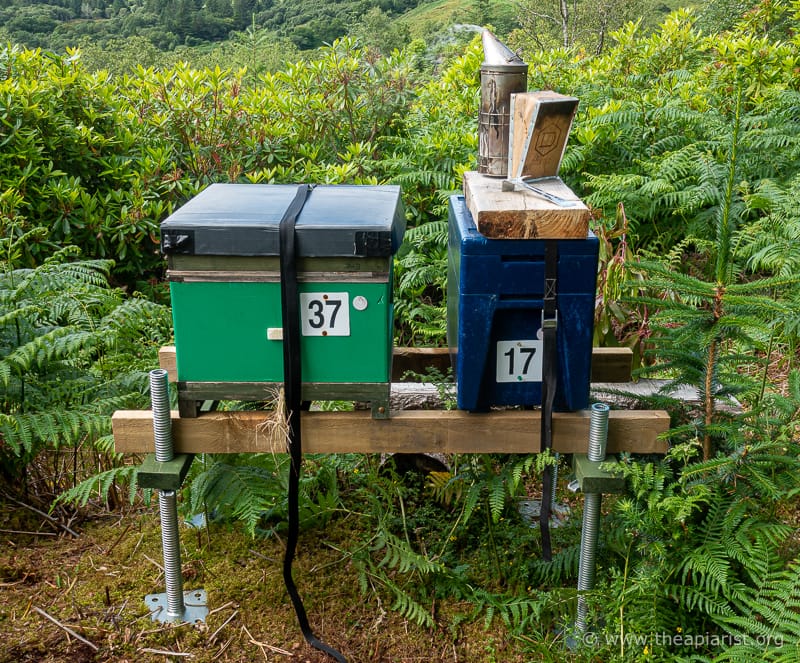
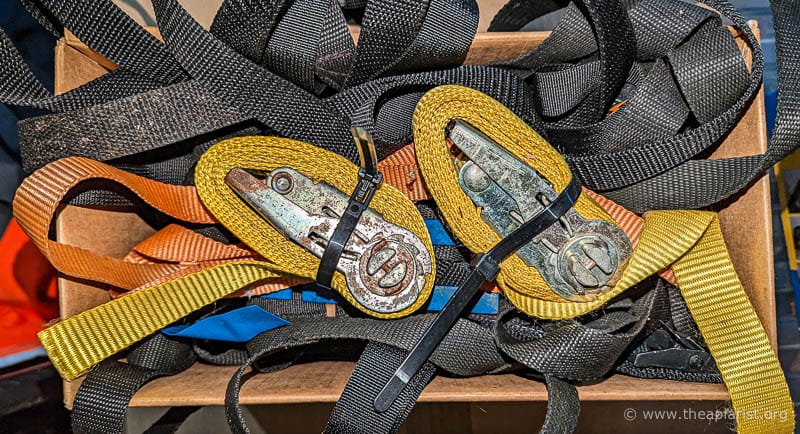
Join the discussion ...